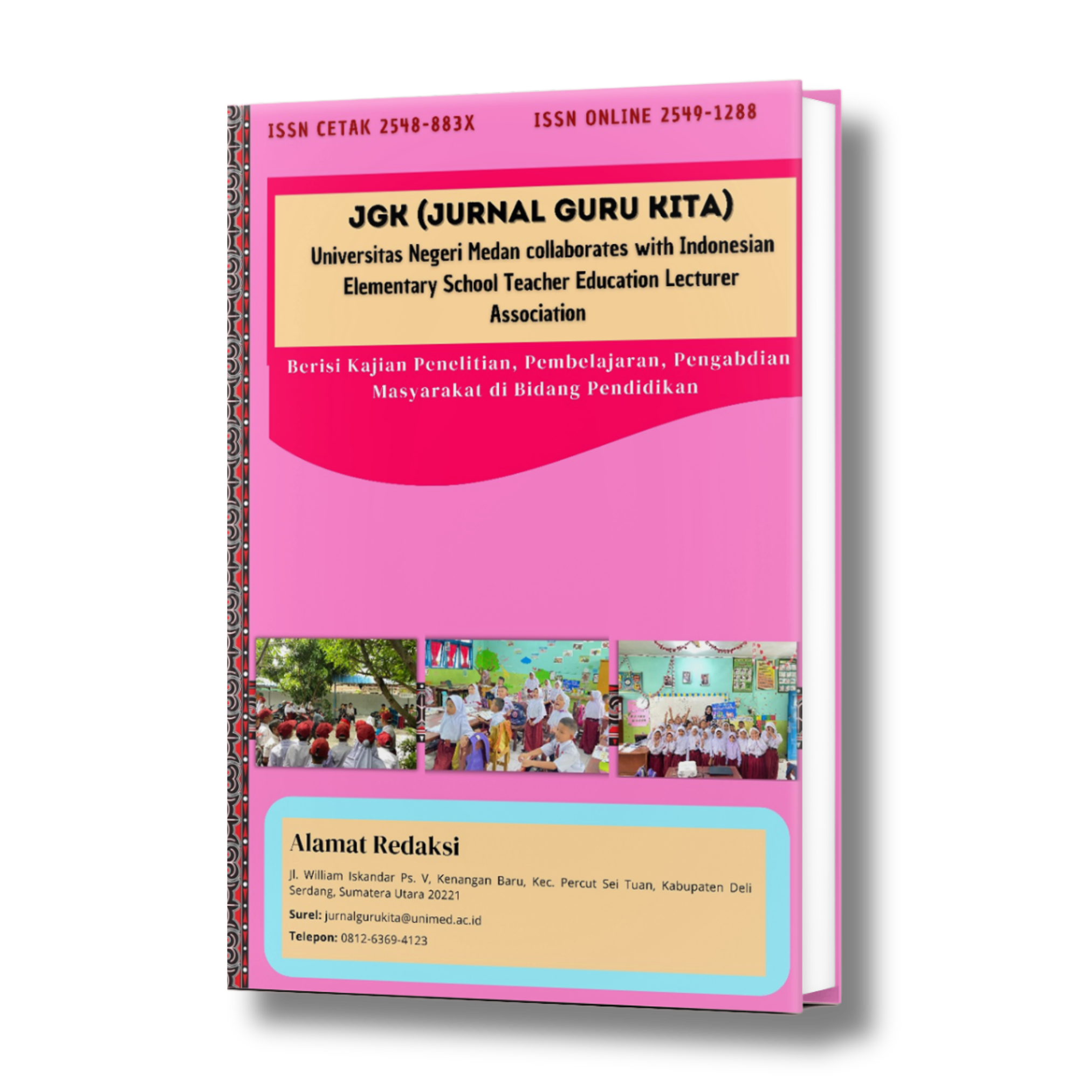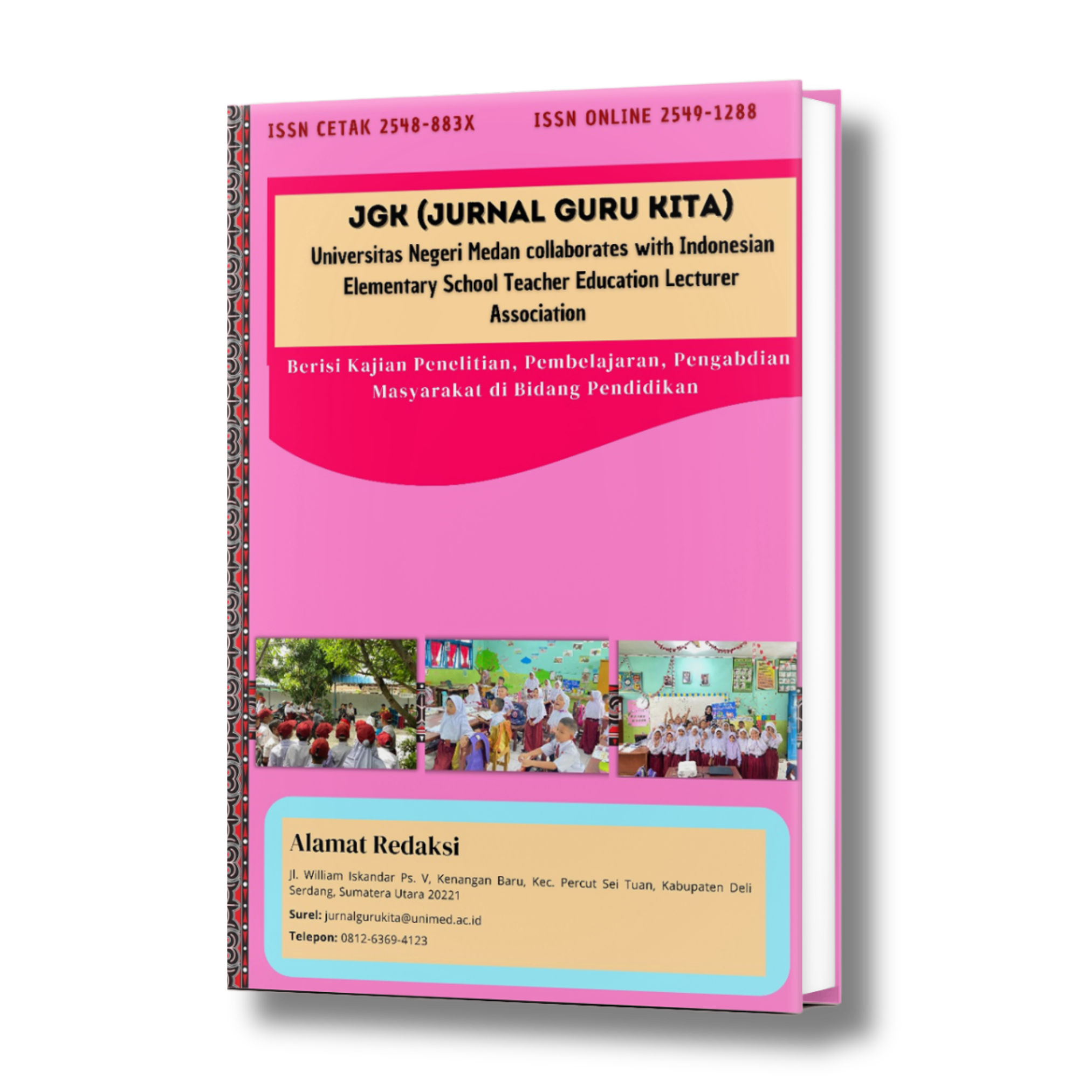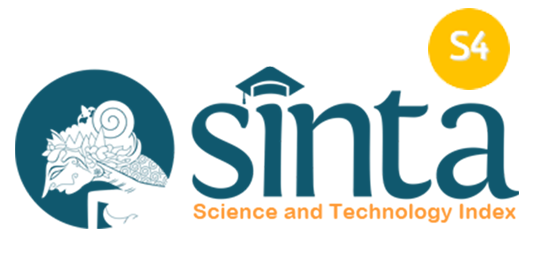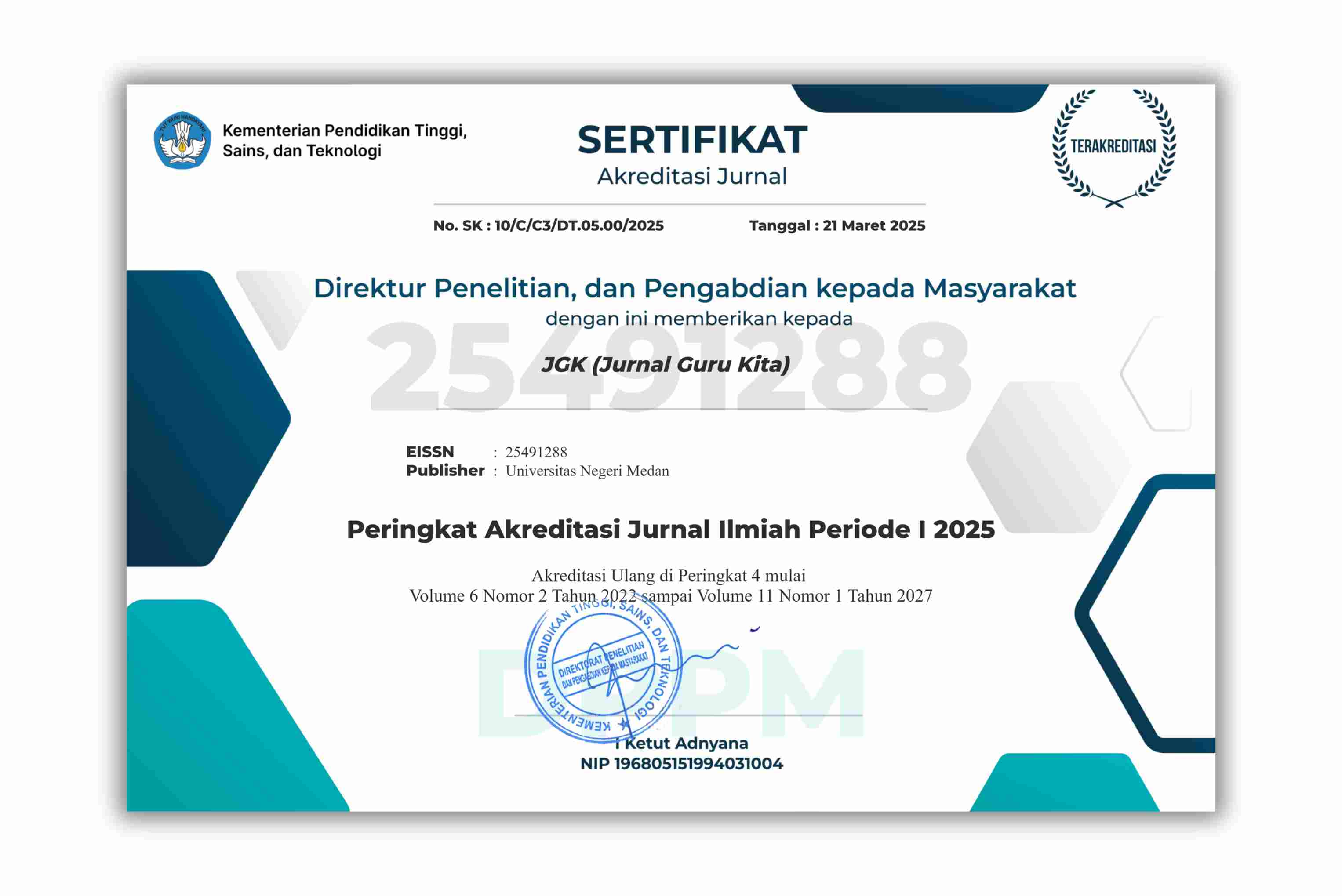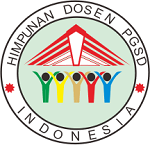Analisis Kesalahan Tata Bahasa dalam Penulisan Cerita Pendek Kelas IV SDN 101766 Bandar Setia
DOI:
https://doi.org/10.24114/jgk.v9i4.69601Keywords:
Kesalahan Tata Bahasa, Menulis Cerita Pendek, Pembelajaran Bahasa Indonesia, Analisis Kesalahan Siswa, Strategi PembelajaranAbstract
Penelitian ini bertujuan untuk menganalisis kesalahan tata bahasa dalam penulisan cerita pendek siswa kelas IV, mengidentifikasi jenis-jenis kesalahan, menganalisis frekuensi dan pola kesalahan, mengungkap faktor penyebabnya, serta memberikan rekomendasi strategis bagi guru dalam pembelajaran menulis cerpen dan tata bahasa Indonesia. Penelitian menggunakan pendekatan kualitatif dengan metode deskriptif kualitatif. Subjek penelitian adalah 27 siswa kelas IV SDN 101766 Bandar Setia. Teknik pengumpulan data meliputi observasi proses pembelajaran, wawancara dengan guru dan siswa, serta analisis dokumen berupa hasil tulisan siswa. Hasil penelitian menunjukkan bahwa kesalahan tata bahasa yang dilakukan siswa meliputi kesalahan ejaan, morfologi, sintaksis, dan tanda baca, dengan frekuensi kesalahan ejaan paling tinggi. Pola kesalahan bersifat berulang, menunjukkan belum adanya internalisasi kaidah bahasa dalam praktik menulis. Faktor penyebab kesalahan meliputi keterbatasan pengetahuan linguistik, kebiasaan literasi yang rendah, strategi pembelajaran yang belum kontekstual, dan pengaruh bahasa sehari-hari. Kesimpulannya, peningkatan kemampuan menulis siswa dapat dilakukan melalui integrasi pembelajaran tata bahasa dengan kegiatan menulis cerpen, pembiasaan literasi, latihan menulis kreatif dengan bimbingan, serta pemanfaatan media dan strategi kolaboratif di kelas.References
Aliyah, N., & Atriyani, I. (2025). Analisis Permasalahan serta Solusi dalam Pembelajaran Bahasa Indonesia dan Matematika di Sekolah Dasar. Karimah Tauhid, 4(6), 3619–3636. https://doi.org/10.30997/karimahtauhid.v4i6.18951
Almelhes, S. (2024). Enhancing Arabic Language Acquisition: Effective Strategies for Addressing Non-Native Learners’ Challenges. Education Sciences, 14(10), 1116. https://doi.org/10.3390/educsci14101116
Arikunto, S. (2014). Metode penelitian kuantitatif, kualitatif, dan kombinasi (mixed methods). Bandung : Alfabeta.
Barroga, E., Matanguihan, G. J., Furuta, A., Arima, M., Tsuchiya, S., Kawahara, C., Takamiya, Y., & Izumi, M. (2023). Conducting and Writing Quantitative and Qualitative Research. Journal of Korean Medical Science, 38(37). https://doi.org/10.3346/jkms.2023.38.e291
Barrot, J. S. (2023). Using automated written corrective feedback in the writing classrooms: effects on L2 writing accuracy. Computer Assisted Language Learning, 36(4), 584–607. https://doi.org/10.1080/09588221.2021.1936071
Bellindo-Garcia, R., Cruzata-Martinez, A., Ponce Marin, M., & Rejas Borjas, L. (2022). Implicit Theories on Learning Assessment and the Use of Triangulation as a Means of Qualitative Validity and Reliability. The Qualitative Report. https://doi.org/10.46743/2160-3715/2022.4231
Berry‐Blunt, A. K., Holtzman, N. S., Donnellan, M. B., & Mehl, M. R. (2021). The story of “I” tracking: Psychological implications of self‐referential language use. Social and Personality Psychology Compass, 15(12). https://doi.org/10.1111/spc3.12647
Budi Rahayu, A. (2022). Error Analysis Of Students’ Independent Writing (A Descriptive Study At The English Department Of STKIP PGRI Nganjuk). Dharma Pendidikan, 16(1), 136–153. https://doi.org/10.69866/dp.v16i1.163
Chand, S. P. (2025). Methods of Data Collection in Qualitative Research: Interviews, Focus Groups, Observations, and Document Analysis. Advances in Educational Research and Evaluation, 6(1), 303–317. https://doi.org/10.25082/AERE.2025.01.001
Colozza, D., Guo, I., Padmita, A. C., Arihandayani, Y., Firna, E., & Avendano, M. (2025). Is obesity associated with depression in low- and middle-income countries? Longitudinal evidence from Indonesia. International Journal of Obesity, 49(6), 1134–1141. https://doi.org/10.1038/s41366-025-01757-x
Creswell, J. W., & Creswell, J. D. (2017). Research design: Qualitative, quantitative, and mixed methods approaches. Sage publications.
Enworo, O. C. (2023). Application of Guba and Lincoln’s parallel criteria to assess trustworthiness of qualitative research on indigenous social protection systems. Qualitative Research Journal, 23(4), 372–384. https://doi.org/10.1108/QRJ-08-2022-0116
Georgakopoulou, A., Giaxoglou, K., & Patron, S. (2023). Small Stories Research. Routledge. https://doi.org/10.4324/9781003253563
Graver, L. (2021). Conrad’s Short Fiction. University of California Press.
Handayani, N. D., & Wardana, I. K. (2025). Assessing the effectiveness of interactive grammar-based teaching in enhancing EFL learners’ concord comprehension and learning confidence. Journal on English as a Foreign Language, 15(1), 30–53. https://doi.org/10.23971/jefl.v15i1.9345
Haristiani, N., & Christinawati, D. (2024). Interlanguage Pragmatic Competence of University Students: An Error Analysis of Apology Speech Act Strategies in Japanese Learners. International Journal of Language Education, 8(1). https://doi.org/10.26858/ijole.v8i1.60904
Jansen, T., Vögelin, C., Machts, N., Keller, S. D., & Möller, J. (2021). Don’t Just Judge the Spelling! The Influence of Spelling on Assessing Second-Language Student Essays. Frontline Learning Research, 9(1), 44–65. https://doi.org/10.14786/flr.v9i1.541
Joye, N., Broc, L., Marshall, C. R., & Dockrell, J. E. (2022). Spelling Errors in French Elementary School Students: A Linguistic Analysis. Journal of Speech, Language, and Hearing Research, 65(9), 3456–3470. https://doi.org/10.1044/2022_JSLHR-21-00507
Karataş, F., Abedi, F. Y., Ozek Gunyel, F., Karadeniz, D., & Kuzgun, Y. (2024). Incorporating AI in foreign language education: An investigation into ChatGPT’s effect on foreign language learners. Education and Information Technologies, 29(15), 19343–19366. https://doi.org/10.1007/s10639-024-12574-6
Kemdikbud, K. (2016). Pedoman Umum Ejaan Bahasa Indonesia. Badan Pengembangan dan Pembinaan Bahasa, Kementerian Pendidikan dan Kebudayaan.
Khair, U., Rihan K, E., & Misnawati, M. (2021). Indonesian language teaching in elementary school. Linguistics and Culture Review, 6, 172–184. https://doi.org/10.21744/lingcure.v6nS2.1974
Klimova, B., Pikhart, M., Benites, A. D., Lehr, C., & Sanchez-Stockhammer, C. (2023). Neural machine translation in foreign language teaching and learning: a systematic review. Education and Information Technologies, 28(1), 663–682. https://doi.org/10.1007/s10639-022-11194-2
Lederman, N. G., Zeidler, D. L., & Lederman, J. S. (2023). Handbook of Research on Science Education. Routledge. https://doi.org/10.4324/9780367855758
Lim, W. M. (2025). What Is Qualitative Research? An Overview and Guidelines. Australasian Marketing Journal, 33(2), 199–229. https://doi.org/10.1177/14413582241264619
Mahdun, M., Chan, M. Y., Yap, N. T., Mohd Kasim, Z., & Wong, B. E. (2022). Production Errors and Interlanguage Development Patterns of L1 Malay ESL Learners in the Acquisition of the English Passive. Issues in Language Studies, 11(1), 74–90. https://doi.org/10.33736/ils.4023.2022
Maruti, E. S., Parji, Hadi, P. K., & Mahardhani, A. J. (2025). Effectiveness of conscientization learning models to improve the awareness of Javanese as a mother tongue for elementary school students in Indonesia. Cogent Education, 12(1). https://doi.org/10.1080/2331186X.2025.2473850
McRae, J. (2022). Literature with a small’l’: Developing thinking skills in language teaching and learning. Wayzgoose Press.
Miles, M. B., Huberman, A. M., & Saldaña, J. (2014). Qualitative data analysis: A methods sourcebook. 3rd. Thousand Oaks, CA: Sage.
Moleong, L. J. (2018). Metodologi penelitian kualitatif. PT Remaja Rosdakarya.
Nasrullah, R., Laksono, K., Prayogi, A., Parmin, P., & Inayatillah, F. (2024). Establishing Literacy Foundations : Policies and Interventions for Indonesia’s Future Excellence. Jurnal Kependidikan: Jurnal Hasil Penelitian Dan Kajian Kepustakaan Di Bidang Pendidikan, Pengajaran Dan Pembelajaran, 10(3), 1219. https://doi.org/10.33394/jk.v10i3.11011
Peng, L., Cui, G., Bao, Z., & Liu, S. (2022). Speaking the same language: the power of words in crowdfunding success and failure. Marketing Letters, 33(2), 311–323. https://doi.org/10.1007/s11002-021-09595-3
Pham, A. T. (2023). The impact of gamified learning using Quizizz on ESL learners’ grammar achievement. Contemporary Educational Technology, 15(2), ep410. https://doi.org/10.30935/cedtech/12923
Prayitno, H. J., Markhamah, Nasucha, Y., Huda, M., Ratih, K., Ubaidullah, Rohmadi, M., Boeriswati, E., & Thambu, N. (2022). Prophetic educational values in the Indonesian language textbook: pillars of positive politeness and character education. Heliyon, 8(8), e10016. https://doi.org/10.1016/j.heliyon.2022.e10016
Ramalingam, S., Yunus, M. M., & Hashim, H. (2022). Blended Learning Strategies for Sustainable English as a Second Language Education: A Systematic Review. Sustainability, 14(13), 8051. https://doi.org/10.3390/su14138051
Scheffelaar, A., Janssen, M., & Luijkx, K. (2021). The Story as a Quality Instrument: Developing an Instrument for Quality Improvement Based on Narratives of Older Adults Receiving Long-Term Care. International Journal of Environmental Research and Public Health, 18(5), 2773. https://doi.org/10.3390/ijerph18052773
Sitorus, J. P. (2019). Mengenal tata bahasa Indonesia. Evernity Fisher Media.
Sugiyono, S. (2019). Metode Penelitian Pendidikan (Kuantitatif, Kualitatif, Kombinasi, R&D dan Penelitian Pendidikan). CV. Alfabeta.
Surahman, A. (2021). Analysis of Fifth Grade Elementary School Students’ Difficulties in Writing Essays. https://doi.org/10.2991/assehr.k.211119.001
Syamsudin, M. H. (2025). Aplikasi Pembelajaran BAB. Pendidikan Bahasa Inggris: Teori, Metode, Dan Aplikasi Pembelajaran, 30.
Utami, I. G. A. L. P., & Mahardika, I. G. N. A. W. (2023). Grammarly and Grammatical Errors Reduction: A Case for Non-Native English Teachers’ Professional Learning. International Journal of Language Education, 7(2). https://doi.org/10.26858/ijole.v7i2.46431
Xia, Y., Shin, S.-Y., & Kim, J.-C. (2024). Cross-Cultural Intelligent Language Learning System (CILS): Leveraging AI to Facilitate Language Learning Strategies in Cross-Cultural Communication. Applied Sciences, 14(13), 5651. https://doi.org/10.3390/app14135651
Yanti, D., Mubarok, Y., Silmi Syafina, L., & Jayatri, P. (2024). Analysis of Indonesian Language Errors in the Hidden Novel. Scope : Journal of English Language Teaching, 8(2), 350. https://doi.org/10.30998/scope.v8i2.17526
Zhao, D. (2025). The impact of AI-enhanced natural language processing tools on writing proficiency: an analysis of language precision, content summarization, and creative writing facilitation. Education and Information Technologies, 30(6), 8055–8086. https://doi.org/10.1007/s10639-024-13145-5
Zhou, S., & Liu, W. (2021). English Grammar Error Correction Algorithm Based on Classification Model. Complexity, 2021(1). https://doi.org/10.1155/2021/6687337
Zhussupova, R., & Shadiev, R. (2023). Digital storytelling to facilitate academic public speaking skills: case study in culturally diverse multilingual classroom. Journal of Computers in Education, 10(3), 499–526. https://doi.org/10.1007/s40692-023-00259-x
Downloads
Published
How to Cite
Issue
Section
License
Copyright (c) 2025 Anggi Muliyanti, Elfi Lumongga Situmorang, Hermalia Putri Pratama, Nazwa Humairoh, Sari Mutiah Siregar, Tiani Sauliana Manurung, Rosmaini Rosmaini

This work is licensed under a Creative Commons Attribution-ShareAlike 4.0 International License.
Authors published with the JGK (Jurnal Guru Kita) agree to the following terms:
- Authors retain copyright and grant the journal the right of first publication with the work simultaneously licensed under a Creative Commons Attribution License (CC BY-SA 4.0) that allows others to share the work with an acknowledgment of the work's authorship and initial publication in this journal.
- Authors are able to enter into separate, additional contractual arrangements for the non-exclusive distribution of the journal's published version of the work (e.g., post it to an institutional repository or publish it in a book), with an acknowledgment of its initial publication in this journal.
- Authors are permitted and encouraged to post their work online (e.g., in institutional repositories or on their website) prior to and during the submission process, as it can lead to productive exchanges, as well as earlier and greater citation of published work. (See The Effect of Open Access)

